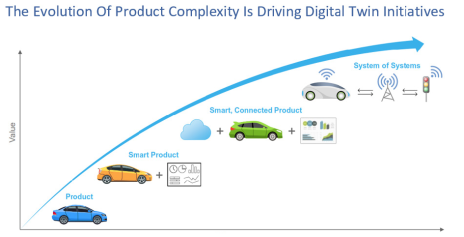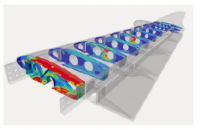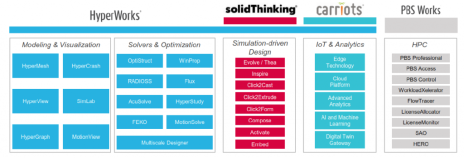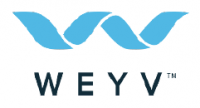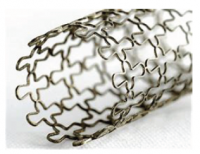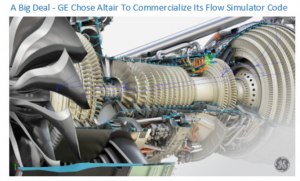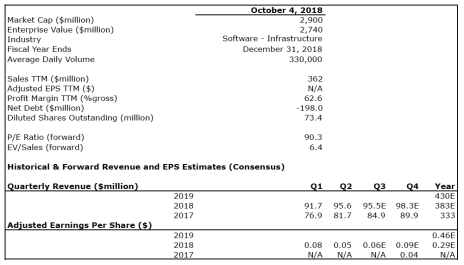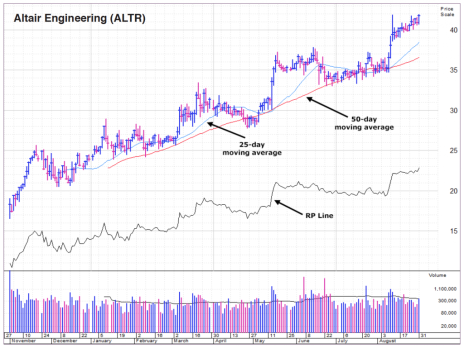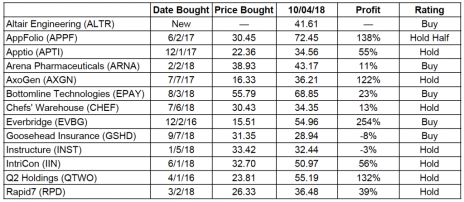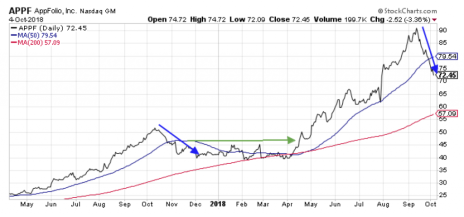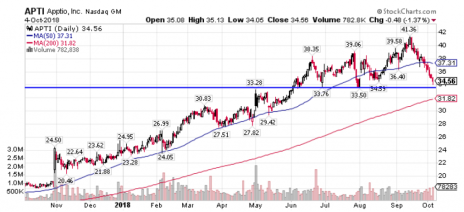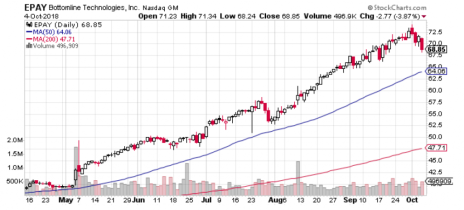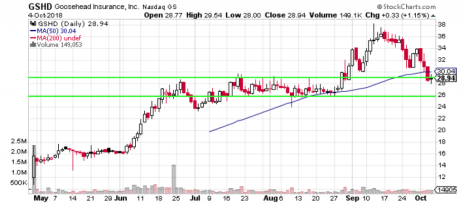Despite weakness in the broad market today’s addition is holding up very well. The company specializes in simulation software – programs that tell users what a physical object, or process, may or may not do.
Cabot Small Cap Confidential 233
[premium_html_toc post_id="161108"]
THE BIG IDEA
Read slowly. This will take some time to digest.
We are on the verge of a renaissance in the industrial manufacturing industry that will forever change how products are designed, built and introduced to market.
This renaissance is being driven by the same forces that are giving rise to artificial intelligence – machines and software that are capable of intelligent behavior. Broadly speaking, these forces are immense computer power available at lower costs, cheaper storage and bandwidth, big data, Internet of Things (IoT), and the cloud.
McKinsey, the global consulting company, says this fourth industrial revolution, or “Industry 4.0”, could drive an eight- to nine-times increase in GDP from established economies if the impact matches the first industrial revolution (which is expected).
And they’re not alone. According to Microsoft, “We are living in revolutionary times for the manufacturing industry. Industry 4.0 is digitally transforming everything around us, right now.”
The foundation of Industry 4.0 is a concept you’re likely not familiar with. It’s called the Digital Twin. And understanding the Digital Twin is necessary to grasp the opportunity represented by this month’s Cabot Small-Cap Confidential addition.
A Digital Twin is a digital replica of a physical object. Think of your car. Now imagine your car – every nut, bolt, wire, semiconductor and inch of metal, rubber and leather, digitized.
Now visualize the physical car driving down the highway, hitting a pothole, getting a flat tire, being steered safely to the side of the road, and then telling you it will take 20 minutes to change the tire and, factoring in traffic, that you’ll be 45 minutes late for work.
That entire process – from design to build to in-use performance and predictive modeling – is also part of the Digital Twin.
In other words, the Digital Twin is not just the digital representation of an object. It can be the digital representation of a dynamic and evolving process – using historical data, current-state analysis and environmental conditions – to predict what will happen, and to optimize performance for the best possible outcome.
The potential of the Digital Twin is incredible. And once it sinks in, it’s easy to see how manufacturing will never be the same.
The potential of the Digital Twin is so immense because it is much more than just one or two powerful technologies working together. It’s all of them: Computer Aided Design (CAD), Computer Aided Engineering (CAE), Machine Automation, Virtual Reality (VR), Augmented Reality (AR), Product Lifecycle Management (PLM), Internet of Things (IoT), simulation – the list goes on.
Especially important are the last two technologies: simulation and IoT.
Simulation is critical because it’s used during the design phase of a product or process to help predict performance in the real world. Let’s return to the example of your car. Better wheel and tire design will evolve from simulated use of different tires under different environmental conditions (weather, road conditions, etc.) until the best design for your location is determined.
IoT is critical because use of connected devices (mostly through sensors) informs simulation programs about performance in-use under different operating conditions. This dynamic data is fed into high performance computing (HPC) infrastructure that can rapidly run simulation scenarios.
A third crucial component of the Digital Twin are cloud platforms. This is especially true for small- and mid-sized organizations that lack the capital to develop the necessary computing power and infrastructure internally. Cloud vendors, including Amazon, Microsoft and Google, allow on-demand access to computing resources that can run simulation programs.
Right now, companies are adopting the concept of the Digital Twin to build better products, save money, get products to market faster, monitor performance, analyze and plot out optimal maintenance schedules, optimize complex manufacturing processes, and more. This trend in manufacturing is just part of the evolution of product complexity, illustrated in the below image.
In short, the Digital Twin is becoming a key strategic initiative to capture growth, drive earnings growth and build and sustain competitive advantage.
As you’ve likely guessed, this month’s portfolio addition is a pure-play Digital Twin company.
THE COMPANY/PRODUCT
Altair Engineering (ALTR) is a $2.8 billion company that develops and sells computer aided engineering (CAE) software to help manufacturing companies innovate across their entire product lifecycle, from concept design, to manufacturing, to in-service operation. At a high level, all of Altair’s customers are involved in some form of product lifecycle management (PLM).
The complexity of managing these lifecycles is rising as consumer tastes become more sophisticated and manufacturing methods evolve. At the same time, there are myriad opportunities to use simulation to help design new products, use new materials and manufacture better goods, all at lower prices and with fewer prototypes, tests and waste.
This is what Altair is all about – transforming design and decision making throughout product lifecycles by applying simulation, machine learning and optimization.
The company is relatively new to the public market. It went public in November 2017 but was founded in 1985. One of the founders, James Scapa, is an engineer by training and began his career with Ford Motor Company in 1978. He is the current Chairman and CEO of Altair, which began as a small consulting operation in the CAE field.
Today, Altair has 71 offices in 24 countries. It generated $333 million in revenue last year and is on target to grow by 15% in 2018, while delivering EPS of $0.29. The company has a blue-chip customer base of tens of thousands of users across roughly 5,000 large manufacturing companies spanning all industries.
Management currently believes the CAE/Simulation market represents a roughly $6 billion opportunity, growing at about 8%. Industry analysts expect that the downward trend in the cost of compute power is a growth driver as it makes simulation software both more affordable to run and accessible to a greater number of engineers.
Management sees a similar growth rate in the high performance computing (HPC) market, which is closer to a $1 billion opportunity. The IoT market is larger (roughly $36 billion) and growing faster (around 15%). IoT is likely to be a driver of growth beyond 2019.
Altair is particularly strong in the automotive, aerospace and heavy equipment markets. It counts 15 out of the top 15 auto manufacturers and 10 out of the top 10 aerospace companies as customers. Automotive now makes up around 40% of the business (down from 100% years ago) and management says demand remains high as autonomous and electric vehicles require powerful simulation software.
Another area of growth to monitor is Altair’s expanding presence in small and mid-sized companies in the architecture, engineering and construction (AEC), energy, life, earth sciences and government markets. No customer accounts for over 3% of revenue.
A Crash Course in Simulation Software
There is a huge variety of ways simulation software is used today. It is used to create 3D simulations when airplanes are designed. It’s used to design and test loads on helicopter rotor blades. And it’s used to help auto manufacturers make lighter cars without sacrificing structural integrity.
It’s a very compute-power intensive field. And manufacturers are challenged with trying to get new products designed and to market as quickly as possible. Running dozens of simulations can take days, even for manufacturers that have invested in extremely powerful computers.
Many just don’t have the resources, so they turn to Altair, which has solutions that can run those simulations in the cloud by tapping into high performance computing (HPC) infrastructure. Cloud infrastructure and pricing is an especially big driver in the small- and mid-sized market.
Altair sprung up from the founders’ vision that simulation, machine learning, and optimization tools can transform design and organizational decision making across a wide variety of engineering disciplines. These include structures, motion, fluids, thermal management, electromagnetics, system modeling and embedded systems.
In the early days Altair’s strength was on both ends of the simulation market, which included pre-processing and post-processing. But investments in R&D and acquisitions have broadened Altair’s portfolio in the middle of the market, which means solvers.
These investments appear to be driving more rapid growth in 2018. In Q2 2018 software revenue was up over 20%, versus roughly 9% growth in the year-ago quarter.
The latest specific customer examples from Q2 were a North American architectural firm that expanded its relationship by adding Altair’s homegrown structural solver solution, and a Japanese equipment manufacturer that expanded into fluids and motion.
Five Categories of Products to Create The Digital Twin
Altair’s software products and R&D initiatives fall in to one of five technical categories, all of which contribute to the creation of digital twin products and processes:
First are solvers and optimization solutions. Solvers are math software engines that use complex algorithms to predict physical performance. Altair is also emerging as a leader in optimization technology, which asks solvers to find solutions to complex design problems where the best outcome must factor in trade-offs between conflicting objectives.
Modeling & visualization solutions use graphical applications to build and visualize data structures, graphics, geometric modeling, mesh generation and user interface design. Altair’s solutions combine decision making and design so users can work on large, detailed and complex products. Cloud delivery helps Altair support virtual and augmented reality hardware.
Industrial & Concept Design solutions fulfill clients’ need to develop early concepts that address ergonomics, aesthetics, performance, and manufacturing feasibility.
Altair’s Internet of Things (IoT) solutions facilitate the design and optimization of products that can easily connect, control and manage information. These IoT tools simplify data collection, exploration and analysis, including the masses of data generated by sensors when devices are in use or through Digital Twin simulations.
High Performance Computing (HPC) aggregates computing power to deliver much higher performance than can be squeezed from a typical desktop computer. Altair’s HPC solutions streamline compute-intensive tasks (solvers, optimization, modeling, visualization, etc.) in fields such as weather modeling, Product Lifecycle Management (PLM) and electronic design analysis.
The Product Lineup
In 2017 Altair generated 84% of revenue ($280 million) from the sale of software and related services, 14% of revenue ($47 million) from embedded Client Engineering Services (CES) and 2% ($7 million) from internally-developed Innovation businesses.
Software: 84% of Revenue
HyperWorks: The HyperWorks suite is designed for simulation specialists and test engineers. Customers have access to all of Altair’s software products (roughly 40 of them), including those from the SolidThinking, Altair PBS Works and Carriots suites, as well as over 150 Altair Partner Alliance (APA) products. HyperWorks drives the bulk of revenue.
SolidThinking: SolidThinking is a subset of the HyperWorks suite and includes around 10 applications for industrial design, concept engineering, manufacturing feasibility and model-based design. These products target small- and mid-sized design, engineering and architect firms. Recently Altair transitioned solidThinking to the same patented units-based subscription licensing model that has worked for HyperWorks (more on this in a minute).
PBS Works: PBS Works is a set of three high performance workload management and optimization solutions (PBS Professional, PBS Access and PBS Cloud) geared toward government, weather, electronic design automation (EDA), biotech and space markets. PBS Works relies on HPC. Users are IT professionals, engineers and scientists, often working at government, research and small commercial enterprises.
Carriots: Carriots is a complete IoT and Machine-to-Machine M2M application enablement platform that Altair acquired in 2017. Clients use it to rapidly connect and manage devices, collect, analyze and visualize big data, build intelligent applications and perform digital twin simulations.
Software Related Services: Altair provides consulting, training and implementation services to help customers get the most out of their software. Because the company’s headquarters include an industrial design studio, prototype shop and test facilities, Altair is well positioned to solve highly technical industry specific engineering problems.
Client Engineering Services (CES): 14% of Revenue
Altair provides engineering services to help customers that can benefit from ongoing product design and development expertise. The benefits of this are twofold: customers get an embedded engineering staff intimately familiar with Altair’s solution capabilities, and Altair generates revenue while staying on the bleeding edge of market trends.
It currently provides CES services to around 30 clients, mostly in North America. Altair hires specialists for placement, most of which work in the fields of simulation, industrial design, materials, development and testing, manufacturing and information technology. The company maintains a database of around 80,000 engineers and designers, and they are employed for the duration of a customer-directed assignment. CES candidates are also a source of talent acquisition for other areas of Altair’s business.
Innovation: 2% of Revenue
Altair’s smallest segment is an internal technology incubator that patents and commercializes technologies developed internally. There are two technologies currently in the market:
Toggled is a next-generation solid-state lighting technology that was formed in 2007. The primary mission of this business is to replace fluorescent light tubes with LED lamps. These lights have no ballast, so they can be dimmed with conventional dimmers.
WEYV is a mobile entertainment app (music, magazines and soon, TV and movies) aimed at the consumer market. It uses Altair’s patented units-based business model so subscribers can tailor their subscription to fit their desires. Management says additional products are in development stages and could be added to the service in the future. WEYV is available in the Apple App store and on Google Play, and integrates with Chromecast, Sonos and Alexa.
How Customers Use Altair’s Software
Daimler: If you look around you’ll notice a lot of Mercedes-Benz automobiles don’t have antennas anymore. At least you can’t see them, because they’re integrated into the windshield. This was no small task and requires a vehicle’s body form part of the antenna. Daimler turned to Altair’s FEKO Windscreen Analysis Tool (part of HyperWorks), which is now a standard process for all windscreen antenna layouts of new car lines.
Ping Golf: Ping designs, engineers and assembles golf clubs. It relies on HPC to do virtual prototyping and analyze all designs. Part of that analysis requires 1.2 trillion calculations to analyze collisions (club head hitting ball), and that compute power would destroy a normal computer. The company uses Altair’s PBS Works to schedule computing resources, save time and improve efficiency.
Medtronic: Medtronic makes medical devices. When designing new stents (expandable mesh inserted into an artery to keep it open) it was moving too slow, so Medtronic worked with Altair to develop an optimization process. The new process allowed Medtronic to perform assessments on 60 design variations overnight, versus several days previously, and identify a design that had 124% better stiffness and 71% reduced stress over the old stent. The bottom line was a better product brought to market more quickly.
Strategic Partnerships - The Altair Partner Alliance (APA)
To fend off competition Altair has developed its Partner Alliance, through which it makes applications from independent software vendors (ISV) available to Altair clients through one unified licensing model. Clients can access around 150 applications from 55 ISV’s by using their licensed HyperWorks units, meaning they don’t need to invest in those software tools separately.
One of the latest additions to the APA is General Electric’s Flow Simulator software, a fluid system design tool that was developed internally at GE. This software is used by around 1,500 GE engineers to perform advanced simulations on aircraft engines. It has helped GE ensure that thousands of airplanes take off, fly and land safely every day. This software is now available to Altair HyperWorks customers, and it’s a big vote of confidence that GE chose Altair to commercialize the code.
The Business Model
Altair generates revenue through sales of software licenses, software-related services, client engineering services and internally-developed innovation businesses. Around 90% of revenue is generated through direct sales, with the balance coming from a network of over 300 indirect channel partners and resellers. No partner/reseller accounts for over 3% of revenue.
One of the compelling aspects of the business model is Altair’s patented units-based subscription licensing model. This means customers license a pool of units for their organization, which gives users access to Altair’s entire product portfolio, plus solutions from the APA. All products are priced in a units-draw basis. Users dip into the pool of units their organization has paid for, then return them when not in use so someone else can use them.
Say an organization licenses 1,000 units that cost $625 per person per year. That’s $625,000 a year. If 10 engineers use Altair’s OptiStruct solution, which draws 50 units, they pull a total of 500 units from the pool. There are 500 units left for other people to use. If one engineer signs off from OptiStruct, his 50 units go back into the pool.
The strategy behind this business model is to reduce friction, let customers use what they need and grow their relationship with Altair over time. Sales people aren’t selling products, per se. They’re selling units. That means salespeople are looking for use cases across all of Altair’s applications (and the APA).
The business model has been working. The average customer uses 15 applications within a given calendar year. Roughly 90% of software revenue is recurring subscriptions, 60% of which is driven by existing customers. The other 40% of software growth is driven by new customers.
Revenue is split nearly evenly from customers in major manufacturing centers around the globe (37% Americas, 32% APAC, 31% EMEA). Billings can be a little lumpy due to the annual renewal cycle of the customer base. Investors should expect higher billings in Q1 and Q4 as compared to Q2 and Q3.
The Bottom Line
Altair wasn’t the most rapid-growth software stock last year. Revenue was up just 6% to $333 million. But growth is accelerating as the company expands its product lineup and salesforce. Revenue in the first two quarters of 2018 was up 19% and 17%, respectively. Consensus estimates call for full-year revenue growth of 15%, to $383 million. In 2019, revenue is expected to grow by 12%.
Importantly, Altair is delivering profitable growth. EPS was $0.08 in the first quarter of 2018 and $0.05 in Q2. In 2018 – Altair’s first full year as a public company – EPS should be around $0.29. EPS should grow by around 60%, to $0.48, in 2019.
These estimates assume Altair is able to deliver the margin expansion it has suggested it will (moving adjusted EBITDA from around 8% now to 20% or more within three to five years), while continuing to invest in R&D and sales.
RISK
Sales Execution: Getting potential clients to sign on the bottom line is one of the main drivers of growth for a business such as Altair. Leadership has been adding quote-carrying direct sales reps and is building out an indirect sales channel as well. Execution within both is necessary to capture market share growth.
Foreign Currency Exposure: Roughly 60% of Altair’s revenue comes from outside the U.S. It is exposed to the euro, pound, Indian rupee and yen. To date, management has not hedged foreign currency exposure, so if there are periods of FX volatility Altair’s revenue could be impacted.
Reluctance To Adopt Cloud Resources in PLM Market: To deliver its solutions Altair relies on cloud infrastructure. To increase adoption manufacturers will need to have confidence in the integrity of these resources, especially if they’re going to connect critical data. That said, use of private and/or hybrid clouds, along with edge computing, can help alleviate concerns for customers that aren’t ready to go “all in”. Altair has been investing in these technologies.
Recent IPO: Altair went public in 2017 so the story is still relatively new to the market.
COMPETITION
Major competitors include Dassault Systemes (DASTY), Siemens (SIEGY), Ansys (ANSS) and MSC Software. Altair’s HyperWorks software is a sticky product that’s dominant at the high end of the market where physics really matter (automotive, aerospace, marine, rail, heavy machinery, etc.). The company faces more competition in the mid-market where its solidThinking product suite competes. Other players with broader Digital Twin offerings include AVEVA, Hexagon, Aspen Technology, Autodesk and PTC.
THE STOCK
Trading Volume: Altair has a market cap of $2.9 billion and trades around 315,000 shares daily. That translates to over $13 million in stock each day, which means we’re unlikely to move the stock. Heavy days are +1 million shares, and that’s happened six days over the last six months.
Historical Price: The company went public on November 3, 2017 at 13 per share. The stock was strong right out of the gate and by March 2018 was solidly above 25. From there the stock has worked higher, mostly above its 50-day moving average line, with short-lived rallies of one to two weeks followed by consolidation phases lasting four to six weeks. Shares entered August trading at 35 and traded up to a 52-week high of 44 earlier this week.
Valuation & Projected Price Target: ALTR’s current share price implies a 6.4x enterprise-value-to-2019-sales (EV/2019 sales) multiple. Provided results continue to be good and investor appetite for profitable software stocks doesn’t deteriorate, shares should be able to sustain a roughly 6.5 EV/2020 sales multiple as we move into the beginning of next year. That implies around 20% upside from here, which is a conservative baseline. We’ll revisit valuation after the next quarterly report. With top- and bottom-line growth accelerating I’d rather start conservative and adjust as we move forward.
Buy Range (next two months): My preferred buy range, if the broad market doesn’t deteriorate any more, is between 38 and 44. That takes us down to the September dip and up to the stock’s 52-week high. That said, if the market weakens we could easily see a larger retreat down into the 34 to 35 range. That would be around 15% below where we are now. Given that we should get support in that range, and that we’d be well within our max 30% stop-loss limit, I would use that as a good buying opportunity. Therefore, my wider buy range for the next two months is between 34 and 44. As always, average in.
The Next Event: Management should announce Q3 2018 results and host a conference in the next two months.
Altair Engineering (ALTR) Financials
Altair Engineering Inc. (ALTR) |
UPDATES ON CURRENT RECOMMENDATIONS
Due to the nature of the stocks recommended, it is to your advantage not to share these recommendations.
Buy means accumulate shares at or around the current price.
Hold means just that; hold what you have. Don’t buy, or sell, shares.
Sell means the original reasons for buying the stock no longer apply, and I recommend exiting the position.
Sell a Half means it’s time to take partial profits. Sell half (or whatever portion feels right to you) to lock in a gain, and hold on to the rest until another ratings change is issued.
Things have deteriorated over the past week and investors are clearly becoming more concerned about a larger correction. The good news is the current corrections in many of our stocks are right in line with previous ones that we have lived through and come out the other end of just fine. I detail some of these in my stock-specific commentary below.
I’m not saying close your eyes and hope for the best. We’re not going to do that. But I am saying that while I’m on the verge of reducing our exposure in a number of positions it’s possible the worst of the selling is behind us.
In terms of catalysts that could right the ship, earnings season is beginning and many of our companies are likely to announce their earnings release and conference call dates in the next one to two weeks. These announcements tend to give investors something tangible to look forward to. It’s a date when they know they’ll be able to connect another dot, find out how the underlying business is doing, and better understand the degree to which a stock’s retreat is a factor of broad market weakness and a valuation reset.
In the past we’ve taken partial profits when things start to fall apart. If we go much lower, we’ll do the same again. I’ve included specific mental stop-loss levels for many of our positions below.
Updates
AppFolio (APPF) continues to act poorly and is now 20% off it’s 52-week high. We’ve already taken partial profits on the stock – back in June, when we were up 108%—and have lived through a decline slightly larger than the current one (shares corrected 23% last October). Given those two factors, plus the fact that APPF has outperformed the small cap index by 122% since I added it, I’m willing to give the stock a little more wiggle room here. I’m not saying the stock looks great and is going to recover next week (I think that’s unlikely). But it’s possible this retreat will end up being similar in nature to last year’s, after which APPF bounced around for a while before moving on to fresh highs. Holding a bit longer gives us the opportunity to participate in that opportunity, should it occur. HOLD.
Apptio (APTI) is also behaving poorly and is 16% off its 52-week high. Last week I said, “The long-term trend is still up and we could endure a deeper dip (down closer to 35) before I’d really start to stare at the chart.” I’m staring at it now and it’s telling me that we should find support around this level (see chart below). This stock hasn’t endured any significant weakness since it broke out last November, and while this correction is starting to hurt it’s not yet time to walk away. Set a mental stop at 32.5. If we get there (roughly 6% lower) we’ll likely take partial profits. A deeper move below the current 200-day line at 31.82 would likely trigger another wave of selling (that’s a major technical support line) and I’d want to protect ourselves against that scenario. I had the stock at buy last week and while that might be appropriate for braver souls, given the market environment and closeness to that mental stop level, I need to move to hold. HOLD.
Arena Pharmaceuticals (ARNA) had an exciting week that culminated in a selloff yesterday that brought it right back to where it was after last Thursday’s close. The news driving the stock has been good safety and efficacy data (released early in the week) from the ongoing open-label extension of the ralinepag Phase II trial in pulmonary arterial hypertension (PAH). Yesterday management hosted an analyst/R&D day and provided more detail on the company’s two most valuable assets (ralinepag and etrasimod), an update on oloriniab, and a teaser on the next pipeline asset being developed. Here’s the scoop:
Ralinepag: Oral prostacyclin, PAH – Data from the Phase II was good and showed sustained benefit for patients that rolled into this extended study and those that switched to ralinepag from placebo. Median treatment duration for patients that rolled over was 1.8 years, versus 1.4 years that rolled over from the placebo arm. The profile for ralinepag looks at least as good as the competition (Uptravi) and supports the notion that prostacyclins could be used earlier in therapy, which would be good for Arena. The company is now moving into Phase III trials which will take a while; if all goes well we’re looking at marketing applications in late 2021 or early 2022. There will be three arms: Advance Outcomes (700 patients), Advance Capacity (140 patients) and Advance Endurance (280 patients). Topline data for Capacity and Endurance should be out in mid-2021 while data for the Outcome study should be in 2022, with potential interim data readout in 2021. Nearer term, Arena is planning a trial to demonstrate switching from Uptravi to ralinepag and management suggested it might look at data after three months from switching. This has the potential to help keep investors a little more engaged as it could de-risk ralinepag and give the market something to look forward to in the mid-term.
Etrasimod: S1P1 modulator, Ulcerative Colitis (UC), Crohn’s – Arena is looking toward a 2023 launch in UC if all goes well in Phase III. There will be two trials with 52-week and 12-week durations. The 12-week should provide data in the second half of 2020, whereas the 52-week should give data in the second half of 2021. Those timelines support an NDA filing in the first half of 2022, which gets us to the theoretical 2023 launch. Arena is also planning two 12-week Phase II/III trials to evaluate etrasimod in Crohn’s. The Phase II component will end at 12-weeks, after which responders will be re-randomized to etrasimod or placebo and continue into the Phase III study which will be evaluated at 52-weeks. These trials should provide data by the end of 2021 and 2022, with the interim data coming in the middle of 2020.
Olorinab: CB2 receptor agonist, GI pain in IBD and IBS – Olorinab is moving into controlled Phase IIb in both Inflammatory Bowel Disease (IBD) and Irritable Bowel Syndrome (IBS). A non-opioid treatment option would be a welcome option for patients that are looking for pain relief. This asset still isn’t being assigned much value since the recent small, open-label study was more of a quick check to ensure it’s worth moving forward than a robust evaluation of the candidate. Management needs to meet with the FDA to figure out details on the next trial design.
APD418: Beta-3 adrenergic receptor antagonist – Arena is advancing APD418 to see if it can improve contractility without adverse hemodynamic changes that would put stress on the heart (i.e. without impacting heart rate or blood pressure). The candidate has been tested on canines and Arena plans to move into toxicology studies with data readout by the end of 2019.
The bottom line here is that data continues to look good and support very valuable assets for Arena, but these trials aren’t going to be over anytime soon. We’re looking out a couple of years before we start to get meaningful data readouts, though some interim data could help keep investors a little more engaged. There is also the potential for a buyout, though management has indicated it would like to move forward on its own (of course they say that!). Standard percentage chances of success apply here: analysts are assuming 70% probability that ralinepag for PAH and etrasimod for UC will make it to market, 40% that etrasimod for Crohn’s will make it to market, and no value yet for olorinab or APD418 since they’re too early stage.
Shares of Arena advanced into the analyst/R&D day and then fell back yesterday, probably because the market was weak and investors are realizing how long it will take before these assets are approved. We’ve known that from the get-go, though I have to admit to getting a little impatient myself. Still, if you can hold on Arena should be a much, much more valuable stock in a few years. The best evidence of that is that even so far away from having a drug to market, Arena has a market cap of around $2 billion. We’ll continue to monitor the chart and take it as it comes. BUY.
AxoGen (AXGN) hasn’t done anything over the past week, which is a victory in my book. The stock has corrected roughly 35% from its peak, which is a larger decline than I typically allow without taking at least partial profits. However, the bulk of that decline came in three sessions and as a practical matter it’s very tough to get out of the way of such rapid moves. Given where we are, which is up 124% from our cost basis with a stock that’s still outperformed by 107% since we added it, and the outright bullish comments by management that indicate the company is on track to still hit guidance and be a 40%-plus grower for several years, the right call now is to sit tight. HOLD.
Bottomline Technologies (EPAY) continues to hold up just fine. The company announced this week that it expanded its Secure Payments solution to monitor a few more payment types (I’ll skip the technical details), which will help customers better detect fraud. Keeping at buy. BUY.
Chefs’ Warehouse (CHEF) was moved to hold a few weeks ago and we’re going to stick with that rating today. The stock retested last week’s low yesterday, but should have a good day today after news broke that it’s being added to the S&P 600 Small Cap Index and funds are moving in. HOLD.
Everbridge (EVBG) is also retesting last week’s low, which happens to be right at the stock’s 52-week moving average line. For the last year this technical level has proved to be a good time to buy so I’ll keep at buy this week. If the stock drops to around 52.5 I will move to hold. BUY.
Goosehead Insurance (GSHD) retreated back into the consolidation price range of 26 to 29 that persisted for most of July and August. This is a touch below the stock’s 52-week moving average line, which as I mentioned last week has only been around for four months so isn’t all that useful of a trendline. We’re down 7% from our entry point and given that we should find support here, or a little lower, I’m keeping at buy. BUY.
Instructure (INST) is trading in a vacuum and has returned to the support zone of around 32 from last fall. I don’t want to put the blinders on and just hold the stock indefinitely, but in my opinion this trading action doesn’t make a lot of sense. Unless the business is starting to deteriorate – and I think the opposite is true – this looks like a chance to buy into a quality company at a very attractive price. That said, I’m not moving to buy today since we like to buy into strength and not weakness. But I’m going to give INST just a little more room before cutting it loose. The depth of the current retreat is about on par with the one from late 2016. If history rhymes, the selling should be just about over. HOLD.
IntriCon (IIN) had found support in the mid-50s until yesterday when it dipped down near 51. We came out of the gates quickly with this stock and still have a 56% gain after three months. But we’re on the cusp of needing to take partial profits to ensure we don’t give it all back. Ultimately, I think the stock should recover and go much higher. But we can’t just hold and hope. Set a mental stop at 50. If the stock closes below that we’ll likely take a partial profit, with the intent of averaging back in if the trend improves. HOLD.
Q2 Holdings (QTWO) has historically been one of our most stable software stocks but, as was the case with many growth stocks, yesterday pulled the stock slightly below recent support. We have a gain of around 130% and have outperformed the small cap index by 84% since adding the position. This correction has pulled QTWO 17.7% below its 52-week high, which is about the same as the 18.2% retreat shares worked their way through late in 2017. We took partial profits when we were up 56% back in July 2017. Now, set a mental stop at 54. If it closes below that price, we’ll consider reducing our position further. Moving from buy to hold today. HOLD.
Rapid7 (RPD) continues to perform just fine. The stock was down 2% this week, which offsets last week’s 2% gain. I moved to hold a few weeks ago and would like to move back to buy. But given the current market backdrop and lack of a clear trend in RPD, we’ll play it a bit conservative and maintain at hold for now. HOLD.
Please email me at tyler@cabotwealth.com with any questions or comments about any of our stocks, or anything else on your mind.
Next Cabot Small-Cap Confidential issue is scheduled for November 2, 2018
Cabot Small-Cap Confidential is published by the Cabot Wealth Network, an independent publisher of investment advice. Neither the corporation nor its employees are compensated in any way by the companies whose stocks we recommend. Sources of information are believed to be reliable, but they are in no way guaranteed to be complete or without error. Recommendations, opinions or suggestions are given with the understanding that subscribers acting on information assume all risks involved. Copyright © 2018 - COPYING AND/OR ELECTRONIC TRANSMISSION OF THIS NEWSLETTER IS A VIOLATION OF THE U.S. COPYRIGHT LAW. For the protection of our subscribers, if copyright laws are violated by any subscriber, the subscription will be terminated.
[premium_html_footer]





